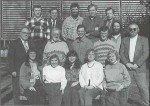For the past two years, scientists from Russia and the H.J. Andrews Forest LTER program have been collaborating on a project that compares the carbon dynamics of two major conifer-dominated regions of the globe. Originally planned at the 1993 LTER All-Scientists Meeting, the project has since involved four joint workshops funded through NSF’s Long-Term Studies Program and International Division. The latest, a two- day symposium to report progress held February 4- 17, 1996 at Oregon State University, Corvallis, was very productive despite heavy rains and flooding that required a hasty evacuation of the Russian participants from their motel!
The overall objective of the collaboration has been to compare the carbon dynamics of the St. Petersburg, Russia area (specifically Leningrad Oblast) to western Oregon and Washington. Both regions are dominated by coniferous vegetation, and the forests are a major economic resource. They differ, however, in terms of climate, potential productivity, and land-use history. Comparison at the regional scale requires a large cast of characters: thus far, the project has involved 20 scientists from the H.J. Andrews Experimental Forest, Oregon State University, and the U.S. Forest Service Pacific Northwest Research Station; the St. Petersburg Forestry Academy, the State Hydrologic Institute, the Komarov Botanical Institute, and the Northwestern Forest Inventory Office (all based in St. Petersburg), as well as the All-Russia Forest Inventory Department of the Russian Federal Forest Service, based in Moscow.
At the first three workshops, held alternately in St. Petersburg and Corvallis in 1994 and 1995, participants developed a general workplan, a detailed Russian workplan, coordinated data gathering and analysis efforts, and the 1996 workshop. Frequent communication has been key to keeping the effort on track and has lead to a healthy convergence of approaches. Initially, the U.S. team was strongly centered on the integration of simulation. modeling and remotely sensed data to determine changes in vegetation condition in a GIS framework, while the Russians took advantage of an abundance of high quality, spatially explicit inventories for forest, wetland, and soil resources. As the project develops, however, U.S. participants are revisiting archival inventory data and Russian participants are applying GIS and remote sensing technologies.
This transition of approaches was most evident in the February workshop, which included working sessions where papers were outlined, data crunched, simulations run, and satellite imagery of the St. Petersburg area was analyzed. The paper abstracts will be published by the LTER Network Office, and participants are developing a book to compare the dynamics of several carbon pools. These comparisons have already shown that:
- Carbon stores in St. Petersburg-area forests have increased over the last 30 years, whereas those in the Pacific Northwest (PNW) have decreased over the same period.
- Carbon distribution in the two regions differs, with roughly a 50:50 mix in live and detrital/soil stores in the PNW versus 70, 15, and 15% stored respectively in peat, live vegetation and detritus/soil pools in the St. Petersburg region.
- Forest products are minor carbon stores in both regions, with approximately 20% of the carbon harvested over the last 100 years still residing as forest products or waste. The proportion of waste to products is quite different, however, with buildings storing 70% in the PNW and industrial manufacturing waste storing 75% in the St. Petersburg area (showing there is more than one way to skin a log!). Other interesting features will no doubt emerge as the project continues.
For more information: M.E. Harmon, 503/750-7333, mHarmon@LTERnet.edu

 Enlarge this image
Enlarge this image